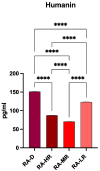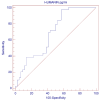Plasma Humanin and Non-Coding RNAs as Biomarkers of Endothelial Dysfunction in Rheumatoid Arthritis: A Pilot Study
- PMID: 39846683
- PMCID: PMC11755443
- DOI: 10.3390/ncrna11010005
Plasma Humanin and Non-Coding RNAs as Biomarkers of Endothelial Dysfunction in Rheumatoid Arthritis: A Pilot Study
Abstract
Background: Rheumatoid arthritis (RA) is a chronic autoimmune disorder associated with an increased risk of cardiovascular disease (CVD), largely driven by peripheral endothelial dysfunction (ED). Humanin, a mitochondrial-derived peptide, has been suggested to play a protective role in endothelial function. However, the relationship between Humanin levels and ED in RA, as well as the interaction between Humanin and non-coding RNAs such as Long Non-Coding RNA GAS5, microRNA-21 (miR-21), and microRNA-103 (miR-103), remains unclear. Objective: This study aimed to investigate the relationship between circulating Humanin levels, non-coding RNAs (GAS5, miR-21, miR-103), and endothelial dysfunction (ED) in patients with RA. Additionally, we explored the correlation between Humanin expression and specific non-coding RNAs (GAS5, miR-21, and miR-103) to better understand their potential role in vascular health. Methods: Peripheral ED was assessed using flow-mediated pulse amplitude tonometry, with Ln-RHI values <0.51 indicating dysfunction. Humanin levels, GAS5, miR-21, and miR-103 were measured in RA patients. Univariate and multivariate analyses were conducted to determine the relationship between these biomarkers and ED. Kaplan-Meier survival analysis and ROC curve analysis were used to assess the prognostic value of Humanin. Results: Higher Humanin levels were significantly associated with better endothelial function (OR = 0.9774, p = 0.0196). Kaplan-Meier analysis demonstrated that higher Humanin levels correlated with improved survival (p < 0.0001). The non-coding RNAs (GAS5, miR-21, and miR-103) did not show significant associations with ED. Conclusions: Humanin is a potential protective biomarker for endothelial dysfunction and survival in RA patients. Further research is needed to explore the interaction between Humanin and non-coding RNAs in the context of vascular health.
Keywords: biomarkers; cardiovascular risk; endothelial dysfunction; humanin; long non-coding RNA; miRNA; rheumatoid arthritis.
Conflict of interest statement
The authors declare no conflicts of interest.
Figures






Similar articles
-
Long non-coding RNA GAS5 suppresses rheumatoid arthritis progression via miR-128-3p/HDAC4 axis.Mol Cell Biochem. 2021 Jun;476(6):2491-2501. doi: 10.1007/s11010-021-04098-1. Epub 2021 Feb 20. Mol Cell Biochem. 2021. PMID: 33611674
-
LncRNA GAS5 alleviates rheumatoid arthritis through regulating miR-222-3p/Sirt1 signalling axis.Autoimmunity. 2021 Feb;54(1):13-22. doi: 10.1080/08916934.2020.1846183. Epub 2020 Nov 20. Autoimmunity. 2021. PMID: 33215529
-
Oxidative Stress Biomarkers and Peripheral Endothelial Dysfunction in Rheumatoid Arthritis: A Monocentric Cross-Sectional Case-Control Study.Molecules. 2020 Aug 25;25(17):3855. doi: 10.3390/molecules25173855. Molecules. 2020. PMID: 32854225 Free PMC article.
-
MicroRNAs in rheumatoid arthritis: From pathogenesis to clinical impact.Autoimmun Rev. 2019 Nov;18(11):102391. doi: 10.1016/j.autrev.2019.102391. Epub 2019 Sep 11. Autoimmun Rev. 2019. PMID: 31520804 Review.
-
The role of non-coding RNAs (miRNA and lncRNA) in the clinical management of rheumatoid arthritis.Pharmacol Res. 2022 Dec;186:106549. doi: 10.1016/j.phrs.2022.106549. Epub 2022 Nov 8. Pharmacol Res. 2022. PMID: 36368452 Review.
Cited by
-
Mitochondria‑derived peptides: Promising microproteins in cardiovascular diseases (Review).Mol Med Rep. 2025 May;31(5):127. doi: 10.3892/mmr.2025.13492. Epub 2025 Mar 14. Mol Med Rep. 2025. PMID: 40084698 Free PMC article. Review.
References
-
- Özkan U., Kakilli N., Gürdoğan M., Taştekin N., Birtane M. Rheumatoid arthritis and cardiovascular comorbidities. Explor. Musculoskelet. Dis. 2023;1:264–288. doi: 10.37349/emd.2023.00028. - DOI
LinkOut - more resources
Full Text Sources

